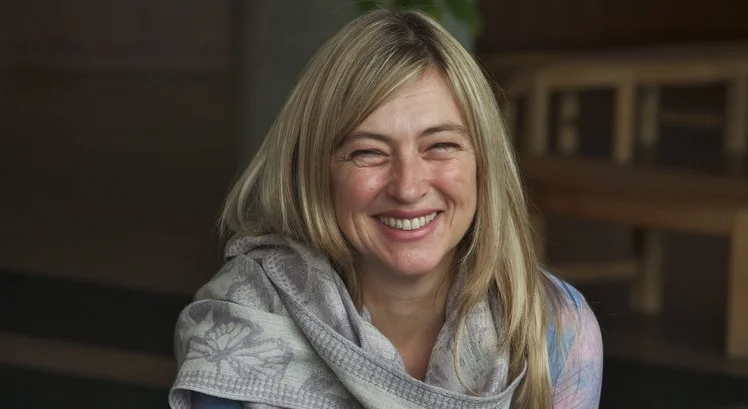As a group, the BST core team is of course interested in how people experience our conference, what they take away from it and what they would tell others about it. To look back at BST18 we asked Petra Sammer to share her thoughts and insights from BST18 “Re-Authoring Futures” with us.
Petra Sammer held a key note at our first conference in Heidelberg focusing on visual storytelling and the power of images. We did the interview through Skype and edited it a bit for readability. It became longer than anticipated, but I believe it is a good read for everyone interested in the atmosphere and the themes present at BST18.
The interview also introduces an event curated by Petra Sammer, “Plot 18” outlining the intention and ideas behind the event.
Going Beyond Storytelling – An interview with Petra Sammer about insights from BST18 and what makes the conference special
Jacques Chlopczyk: You have been twice at BEYOND STORYTELLING, in our first conference as a key note speaker and this year as an attendee. What made you come again?
Petra Sammer: When I came the first time to BST, as a key note speaker, I had the expectation that it is an ordinary conference. But I discovered quickly that one can better describe it as an experience. It is a completely different format compared to usual conferences. And I really enjoyed it.
How would you describe this experience?
The astonishing thing for me is that a bunch of strangers come together, and when they enter the room at BST they turn into friends.
a bunch of strangers come together, and when they enter the room at BST they turn into friends.
What is really not happening, is promotion or selling of one´s own ideas trying to make a point. This does not happen at BST. Everyone is focused on stories. And this makes it unique.
A lot of conferences are structured in the same way, BEYOND STORYTELLING breaks these rules
Yes, we try to create a special atmosphere with BEYOND STORYTELLING, focusing on high quality input, but also space to connect and learn from and with each other. Is there anything else that distinguishes BEYOND STORYTELLING from other events from your point of view?
The variety of formats! This seems banal, but it isn´t. Somehow, I feel that a lot of conferences are structured in the same way: you have people talking from the stage, maybe a plenary session. BEYOND STORYTELLING breaks these rules. It has workshops, break-out sessions, discussions in small groups and a process that keeps it all together.
What really struck me, was the end of Day 1. I never attended a conference where 100 people were having a real conversation together, this is unbelievable – but it is working. I do not know how you do it, but it is working.
This inspiring flow of the day differentiates you very much from other conferences.
BEYOND STORYTELLING raised my awareness for the different ways that people work and approach story
You are an expert in the field of Storytelling and in your outstanding career as a marketeer you worked with a lot of different brands and companies supporting them in telling the right kind of stories that create a spark with their audience. We are bringing people together with very diverse backgrounds, but a common denominator: They all work with stories in some way or another. What struck about this?
BST opened my eyes that there are so many fields. Before, I thought Storytelling is about film, literature and my area of marketing and PR. Participating in BEYOND STORYTELLING raised my awareness for the different ways that people work and approach story.
This also helped me also on a very personal level: Through BST I became more patient with my clients. I learned that there is a beauty in understanding that there are different approaches to use story and different ideas what storytelling is and can be. I became much more tolerant and patient with different versions of storytelling.
Is there a special moment that stands out for your from BST18?
The key note from Joe Lambert. He invited us into a mental journey to the future – very interactive, funny, but also a moment of stillness and reflection. And it was a wonderful moment of collaboration: He asked us to take away all chairs and we move step by step into the future – along with his thoughts.
What also inspired me – and validated my own views – was the importance he placed on movies or visuals in the telling of stories. Today, visuals are so fundamental for the way we communicate. Not only in external communication and branding, but also in internal communication.
And what I saw here is someone extending this visual turn even further working in coaching and personal development. He showed a wonderful movie from one of his workshops in which an attendee developed a movie to work through her experiences with her parents. And this usage of film, to work through difficult memories, traumas or experiences was wonderful.
What are particular insights or questions that you take away from the conference?
To somehow summarize my key learning: the discussion how stories shape our views of the world. This may sound simple, but it isn´t. For me as a marketeer, I am very much accustomed to see story as one tool among many to sell a product.
But at BEYOND STORYTELLING, I got in touch with immense power that stories have, how they are vehicles to shape the way we see the world, beyond being just a tool for marketing. This was embedded in your overall theme “Re-Authoring Futures” and therefore in many discussions.
Do you recall any of these discussions?
I had an exchange with Michael Müller on the “Monster in the House”. It´s a plot structure, very common to horror movies. The protagonists are trapped in a house with a monster. In this situation, there are only two options: fight or flight.
He makes a good argument that complex topics like Digitalization or Globalization are understood as a “Monster in the House”-plot. And if you approach a problem in such a way, you think inside the box. This is a powerful insight to understand why some discussions are the way they are: We story them in a way that is not helpful in finding new, creative solutions.
Another line of thought that emerged during these two days is that there is a responsibility on the corporate side to tell better stories. Not so much about their companies but even more about the future of our societies. About how they want to transform the future and what´s their contribution. I dó not think that they are aware of this responsibility.
there is a responsibility on the corporate side to tell better stories
What do you mean by that?
A couple of weeks ago, I had a workshop with a German public television agency. Public television is very much under attack these days and we were searching for new ways to present them to the public.
We talked about the stories they tell about themselves. And we quickly discussed their purpose. They responded that they are important for democracy because they guarantee free speech and keeping different viewpoints and opinions visible.
But this didn´t show up in their press releases. They didn´t talk about how the future would look like without them and what kind of future they are standing for. So this was key at BT: tell the stories about the future you want to live into, not only your own or the one of your company, but the future of our societies and out planet.
BEYOND STORYTELLING is an easy trip to experience and learn a lot
Given these inspirations, why you think it is worthwhile for marketeers to participate in BEYOND STORYTELLING?
First of all – to learn about how to tell stories. Storytelling will not go away, it is at the core of our profession: creating good content.
The second is the connection between story and change. How you use story in your company! How you use story to increase the worth of your company, how to be smarter, how to work more collaboratively! There is only a tiny little step between telling new stories and creating change in your environment.
The third point for me is about learning the different ways of working with story. Story listening for example. At first this was a bit strange for me: “Ah, they call it story listening now…”. But I leaned at BT what you mean by this. Listening to someone’s story gives you so much more information than just the story. Before we react to the story, you should listen deeply, not only as a marketeers but also as a leaders.
Last but not least, BEYOND STORYTELLING is an easy trip to experience and learn a lot. You do not have to read a book. It doesn´t feel like working. It is an enjoyable experience. You just go there, spend two days with interesting, smart and funny people, friends, and you learn so much!
On September 13, you are hosting the event „Plot18“ in Munich. What can people expect from this event? What is it about?
It is about “marketing meets film” and “business meets creativity”. Two communities and industries, that can learn so much from one another – both talk about storytelling and both talk about visuals. And “Plot18” brings these two together.
It is about showing to business people what movies can do – from innovative and low-budget production techniques to new ways of telling stories. For instance, one of the sessions focuses on empowering people to do good content with just a smartphone in an easy, innovative way.
And we also want to show what is possible in the world of corporate film. As a creative, you do not want to give away all of your creative freedom. But corporate film is no longer only about product placement. Today, there are so much more possibilities: New projects and new approaches. The best ones, like “Crafted” from Haagen Dazs are made without any interference by the company. And we want to show these projects too.
We will also touch on developments that shape the field we are working in at the moment. Developments like Virtual Reality, agile movie production or Experiental Storytelling. Developments that you need to take into account if you work in this field, otherwise others will have done it! So, join us there.
Beautiful, we already booked our tickets. Thanks for this interview!
More information on:
· Plot 18: http://whattheplot.com/
· Petra Sammer: https://www.petrasammer.com/










